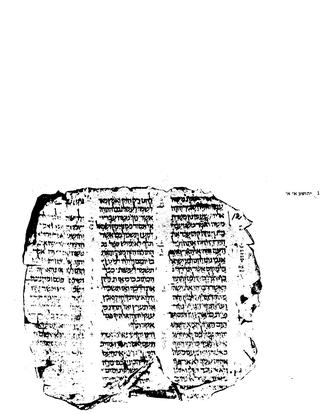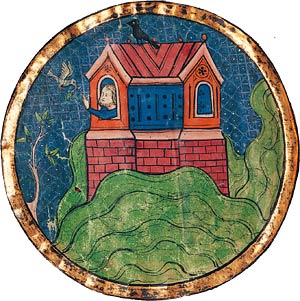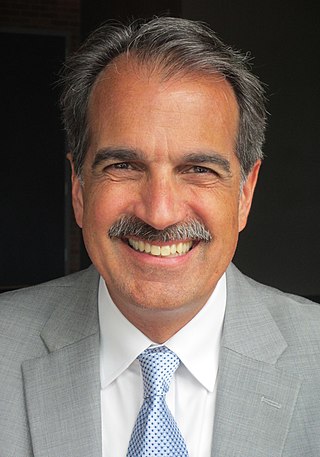Related Research Articles

The Samaritan Torah, commonly called the Samaritan Pentateuch, is a text of the Torah written in the Samaritan script and used as sacred scripture by the Samaritans. It dates back to one of the ancient versions of the Hebrew Bible that existed during the Second Temple period, and constitutes the entire biblical canon in Samaritanism.

Av is the eleventh month of the civil year and the fifth month of the ecclesiastical year on the Hebrew calendar. It is a month of 30 days, and usually occurs in July–August on the Gregorian calendar.
Gregory Bar Hebraeus, known by his Syriac ancestral surname as Barebraya or Barebroyo, in Arabic sources by his kunya Abu'l-Faraj, and his Latinized name Abulpharagius in the Latin West, was a Maphrian of the Syriac Orthodox Church from 1264 to 1286. He was a prominent writer, who created various works in the fields of Christian theology, philosophy, history, linguistics, and poetry. For his contributions to the development of Syriac literature, has been praised as one of the most learned and versatile writers among Syriac Orthodox Christians.

The maqāma is an (originally) Arabic prosimetric literary genre which alternates the Arabic rhymed prose known as Saj‘ with intervals of poetry in which rhetorical extravagance is conspicuous.
Aaron ben Moses ben Asher was a sofer who lived in Tiberias. He perfected the Tiberian system of writing vowel sounds in Hebrew. The system is still in use today, serving as the basis for grammatical analysis.

Judeo-Berber or Judeo-Amazigh is any of several hybrid Berber varieties traditionally spoken as a second language in Berber Jewish communities of central and southern Morocco, and perhaps earlier in Algeria. Judeo-Berber is a contact language; the first language of speakers was Judeo-Arabic. Speakers immigrated to Israel in the 1950s and 1960s. While mutually comprehensible with the Tamazight spoken by most inhabitants of the area, these varieties are distinguished by the use of Hebrew loanwords and the pronunciation of š as s.

Dunash ha-Levi ben Labrat was a medieval Jewish commentator, poet, and grammarian of the Golden age of Jewish culture in Spain. He is known for his philological commentary, Teshuvot Dunash, and for his liturgical poems D'ror Yiqra and D'vai Haser.

Rabbi Solomon Aaron Wertheimer, was a Hungarian rabbi, scholar, and seller of rare books.
Norman Golb was a scholar of Jewish history and the Ludwig Rosenberger Professor in Jewish History and Civilization at the Oriental Institute of the University of Chicago.

The Codex Cairensis is a Hebrew manuscript containing the complete text of the Hebrew Bible's Nevi'im (Prophets). It has traditionally been described as "the oldest dated Hebrew Codex of the Bible which has come down to us", but modern research seems to indicate an 11th-century date rather than the 895 CE date written into its colophon. It contains the books of the Former Prophets and Latter Prophets. It comprises 575 pages including 13 carpet pages.
Yosef Goldman was a scholar of American Jewish history and the co-author of the two-volume reference work, Hebrew Printing in America 1735-1926: A History and Annotated Bibliography (2006). This work is usually cited by auctioneers and rare-book dealers. His collection of early American Judaica and Hebraica is said to be one of the most comprehensive in the world.

Nakdimon Shabbethay Doniach was a British civil servant, lexicographer and scholar of Judaic and Semitic languages.
Aaron of Jerusalem, also known as Abū al-Faraj Hārūn ibn al-Faraj, was a Karaite Jewish scholar of the eleventh century who resided in Jerusalem.
Leser Landshuth was a German Jewish liturgiologist.
Aaron ben Gershon Abu Al-Rabi of Catania was a Sicilian-Jewish scholar, cabalist, and astrologer of the 15th century.

The North French Hebrew Miscellany or "French Miscellany" or "London Miscellany" is an important Hebrew illuminated manuscript from 13th-century France, created c. 1278-98. A miscellany is a manuscript containing texts of different types and by different authors, and this volume contains a wide range of Hebrew language texts, mostly religious but many secular. The manuscript is exceptional among medieval Hebrew manuscripts both for its size and the diversity of the texts and the quality and lavishness of its illuminations, which as was often the case were added by Christian specialists.

Jean Hurault de Boistaillé (1517–1572) was a French nobleman and government official. In 1558 he was an emissary of the king Henry II, then ambassador of France in Constantinople and Venice (1562–1564). He played an important role in getting military support from the Ottoman Empire in the Italian War of 1551–1559. He was a bibliophile and collector of manuscripts and incunabula. He died in England in 1572 during his diplomatic mission.

Gary A. Rendsburg is a professor of biblical studies, Hebrew language, and ancient Judaism at Rutgers University in New Brunswick, New Jersey. He holds the rank of Distinguished Professor and serves as the Blanche and Irving Laurie Chair of Jewish History at Rutgers University (2004–present), with positions in the Department of Jewish Studies and the Department of History.
Aaron David Rubin is an American linguistics researcher. He is currently the Ann and Jay Davis Professor of Jewish Studies at The University of Georgia. From 2004 to 2023 he was Malvin and Lea Bank Professor of Classics & Ancient Mediterranean Studies, Jewish Studies, and Linguistics at Penn State University. His main area of study is the Semitic language family, focusing on Hebrew, Arabic, Aramaic, and the modern languages of Southern Arabia, especially Mehri and Jibbali. He has also worked extensively on non-Semitic Jewish languages, as well as on Hebrew and Jewish manuscripts. At Penn State, he has taught numerous language courses, as well lecture courses on the Bible, Jewish and Ancient Near Eastern literature, and the history of writing systems. He received a Guggenheim Fellowship in 2016.

Judeo-Urdu was a dialect of the Hindustani language, spoken by the Baghdadi Jews in the Indian subcontinent living in the areas of Bombay and Calcutta towards the end of the 18th century. It is a dialect which was written in the Hebrew script, and found to be utilised for a number of pieces of literature, such as Inder Sabha, a copy of which is kept at the British Library.
References
 This article incorporates text from a publication now in the public domain: Singer, Isidore; et al., eds. (1901–1906). "Aaron the Bookseller". The Jewish Encyclopedia . New York: Funk & Wagnalls.
This article incorporates text from a publication now in the public domain: Singer, Isidore; et al., eds. (1901–1906). "Aaron the Bookseller". The Jewish Encyclopedia . New York: Funk & Wagnalls.